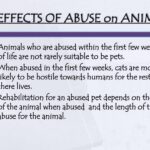Animal cruelty continues to be a pressing ethical issue around the globe, prompting a host of questions surrounding the efficacy of governmental measures in combatting this pervasive problem. As society evolves, so too does the expectation that governmental bodies will implement robust policies to protect the welfare of animals. Yet, the disparity between policy creation and practical application persistently raises eyebrows: Are these policies genuinely making a difference, or are they merely placating concerned citizens without contributing to real change? This article delves into the current state of governmental action against animal cruelty, examining the intricacies of policy versus practice.
In recent years, awareness surrounding animal rights has grown exponentially. Advocates tirelessly push for more stringent regulations to thwart abuse, neglect, and exploitation of animals. Many states and countries have taken legislative strides by enacting animal welfare laws, creating dedicated agencies, and imposing penalties for transgressors. These initiatives signal a commitment to protecting animals, yet the implementation surrounding these policies is where the true battle lies.
One of the most significant strides in the realm of animal welfare involves the establishment of comprehensive legislative frameworks designed to safeguard various species. These include prohibitions against inhumane treatment, regulations regarding animal breeding and pet ownership, and laws punishing individuals who inflict harm upon animals. However, despite these laudable intentions, gaps in enforcement often undermine these measures. Local organizations, often underfunded and understaffed, frequently face insurmountable challenges when attempting to enforce regulations. This begs the question: when laws are enacted, what mechanisms exist to ensure their enforcement?
Furthermore, the disparity in animal welfare standards from one jurisdiction to another complicates the landscape. In some areas, animals enjoy robust protections, whereas, in others, laws are minimal, creating a patchwork of regulations that can be easily exploited by unscrupulous individuals. Take puppy mills, for example. While some states impose strict regulations requiring humane conditions, others suffer from minimal oversight, allowing such establishments to flourish unchecked. This inconsistency in enforcement can lead to a devastating cycle of abuse, raising critical questions about accountability.
In addition to regulating private individuals, governments must also grapple with industries that exploit animals for profit. The agricultural sector, particularly factory farming, exemplifies an area where ethical dilemmas collide with profit motives. Policies aiming to improve animal welfare in these industrial settings often fall short in their implementation. While laws may outline standards for humane treatment, the reality on the ground often reflects a stark contrast. In many instances, the pressure to maximize efficiency and minimize costs outweighs the commitment to animal welfare, leaving countless creatures subjected to preventable suffering.
One of the most poignant examples of this conflict lies in the grey area of “humane” farming practices. Despite the introduction of terms like “cage-free” and “grass-fed,” the reality of how these animals are treated can remain obscured by marketing jargon. Regulatory bodies may permit practices that allow for significant suffering under the guise of humane treatment. Herein lies a critical challenge: how can consumers distinguish the difference between genuine welfare and mere marketing gimmicks?
Moreover, when discussing animal cruelty legislation, it is crucial to acknowledge that these laws often do not address the psychological aspects of human-animal relationships. While punitive measures may deter some from committing acts of cruelty, they fail to tackle the underlying issues contributing to such behavior. Education programs targeting empathy and responsible pet ownership are equally essential as they pave the way for long-term societal change. Governments must not only legislate but also educate, fostering a culture of respect and compassion toward all living beings.
Interestingly, public sentiment toward animal rights has increasingly influenced governmental action. As citizens voice their concerns, the pressure on lawmakers mounts to implement reforms. Petitions, advocacy campaigns, and social media mobilization have all contributed to raising awareness and pushing for legislative changes. But does public pressure effectively lead to systemic change? Or, is it merely a fleeting response that lacks the tenacity required for long-term reform?
The complexity of enforcement further complicates the achievement of tangible results. Inspectors and animal control officers often face bureaucratic obstacles, inadequate training, and limited resources. This situation raises a compelling challenge: can the government allocate sufficient funding and expertise to enforce animal welfare laws effectively? Inadequate resources can impede the best intentions, leaving the most vulnerable animals without the protections they desperately need.
As society continues to grapple with the intersection of legislation and morality, the dialogue surrounding animal cruelty remains fraught with challenges. The stark reality often reveals that policies, while well-intentioned, falter under the weight of practical limitations. The question moving forward is not merely about passing legislation, but also about the commitment to ensuring enforcement, accountability, and the fostering of a society that truly champions animal welfare.
In conclusion, while governments across the globe take steps to combat animal cruelty through policy frameworks, the enforcement and practical application of those laws frequently tell a different story. The real test lies ahead: determining ways in which policy can be harmonized with practice to create an effective, compassionate system that prioritizes animal welfare at all levels. As advocates for animal rights continue their quest, it is crucial that they engage with these complexities, pushing not only for stronger laws but for a cultural shift that places empathy at the forefront of our relationship with animals.







